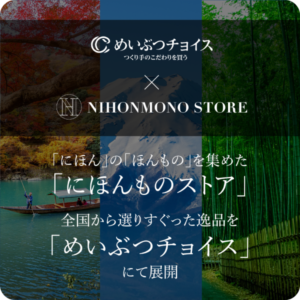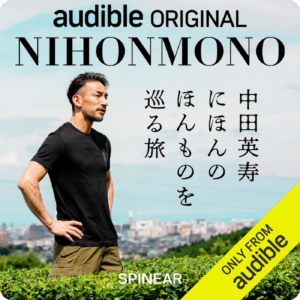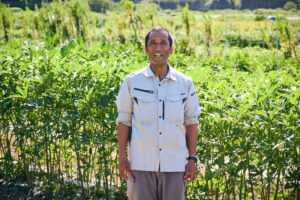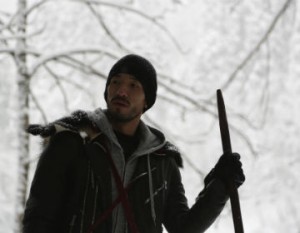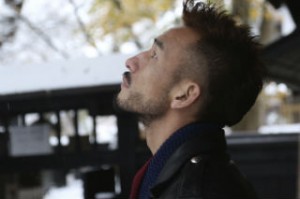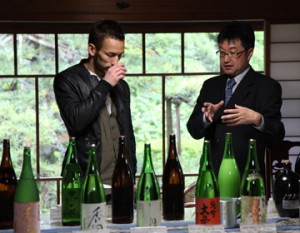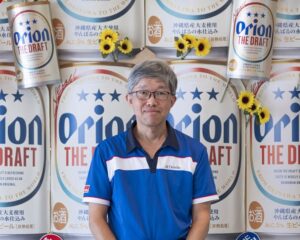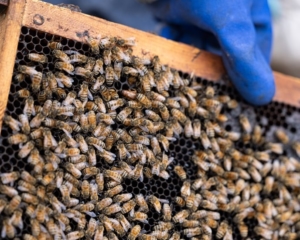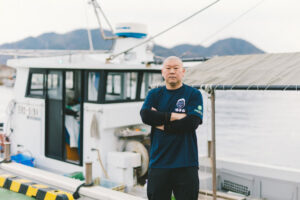The Ariake Sea is one of Japan’s leading seaweed production areas. Surrounded by four prefectures in Kyushu, the inland sea is known for its fertility due to the nutrients flowing in from the Chikugo River and many other incoming rivers. Mr. Tetsuya Koga of Ariake Suisan in Okawa City, Fukuoka Prefecture, runs a laver cultivation business in such an Ariake Sea fishing ground. Through Mr. Koga’s integrated operations, from seaweed cultivation to processing and sales, we learn about the appeal of the Ariake Sea and the reason why seaweed is so delicious.
The Ariake Sea’s unique environment is ideal for seaweed cultivation
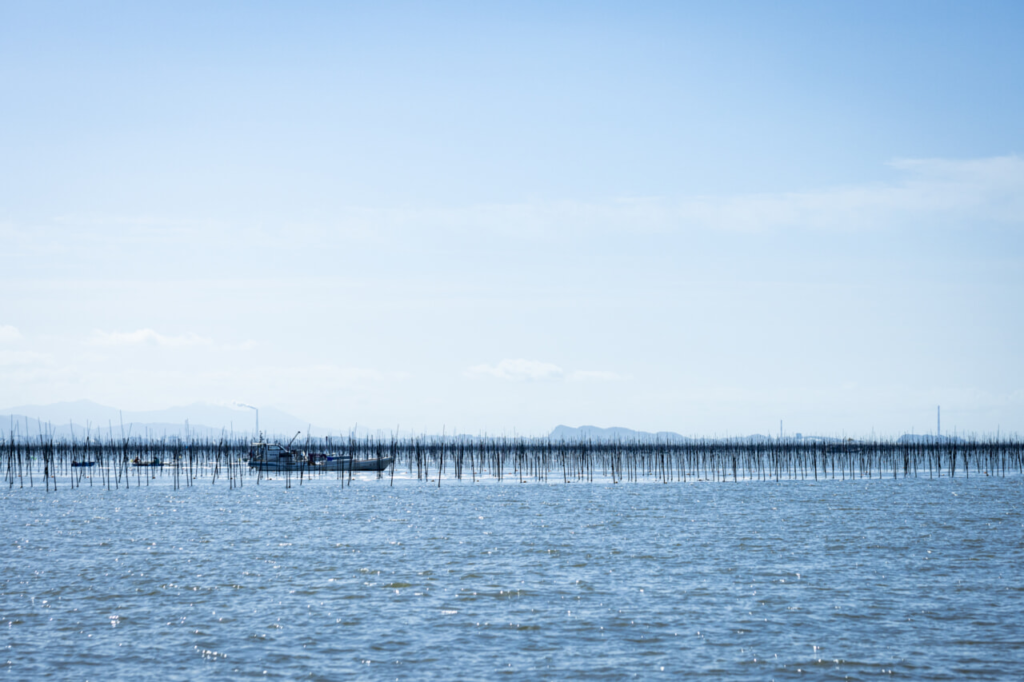
Crispy and thick. The moment you put it in your mouth, the aroma of the sea and its delicious flavor wafts into your nostrils. Everyone agrees that the seaweed from the Ariake Sea is different after all. Behind such a reputation, the Ariake Sea is said to be a “treasure sea” because of its blessed environment and the pride of its laver fishermen.
The Ariake Sea is the largest bay in northern Kyushu. Surrounded by the four prefectures of Nagasaki, Saga, Fukuoka, and Kumamoto, it is a closed sea with a narrow bay mouth that opens to the south. The tidal range (the difference between high and low tides) is the largest in Japan at 6 meters, and vast mudflats appear twice a day at low tide. The area is also famous for its unique ecosystem, which is inhabited by mudflats and other tidal flat organisms.
In addition, more than 100 rivers of various sizes, including the Chikugo River fed by Mt. Aso, flow into the Ariake Sea, mixing fresh water and seawater and creating a salinity suitable for seaweed cultivation. Combined with the large difference in tidal range that promotes photosynthesis necessary for laver growth, the sea is an ideal environment for laver cultivation, and in the 1960s it became one of the leading production areas in Japan. It is truly a sea of treasures. The quality of the seaweed produced in the Ariake Sea has also made it one of Japan’s most prized products.
Making the most of Japan’s largest difference in tidal range to grow laver
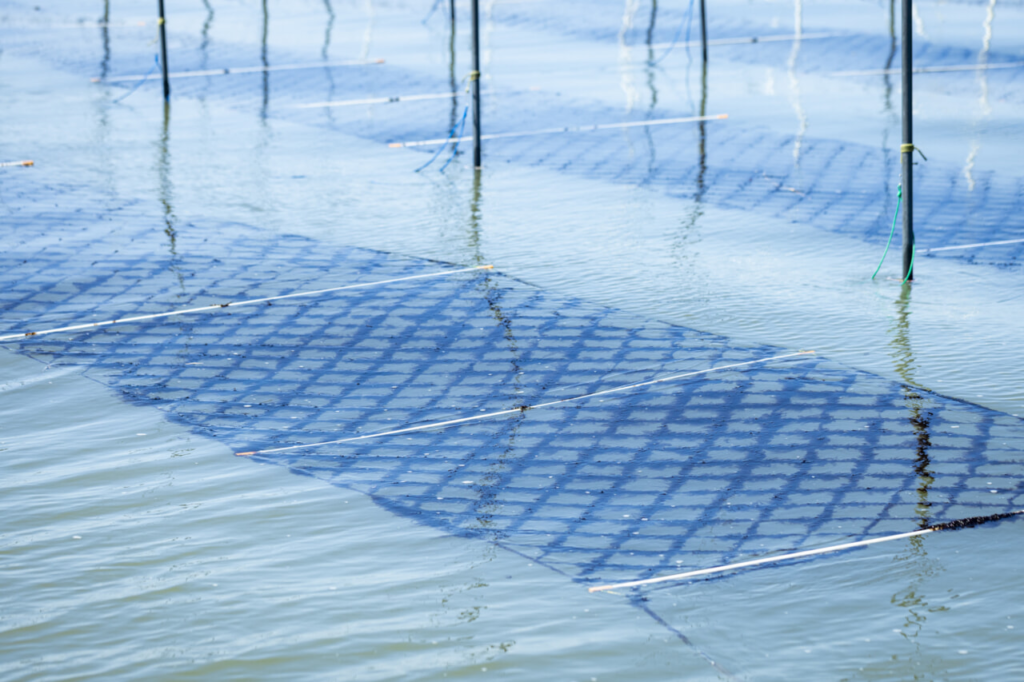
Nori cultivation in the Ariake Sea began in earnest around 1955. This was much later than in Tokyo Bay, where laver cultivation is said to have first begun in Japan during the Edo period (1603-1867). When seaweed cultivation began to flourish in the Ariake Sea, Koga’s grandfather started seaweed cultivation in Okawa City, Fukuoka Prefecture, on the eastern coast.
In the Ariake Sea, a cultivation method known as the “prop method” is used, which makes the most of the difference between the tidal range and the ebb and flow of the tide. As the tide recedes and the laver is exposed to the cold wind, at the same time it is dried in the sun, which increases its amino acid content. This increases the amino acid content of the laver, resulting in a more flavorful and aromatic laver. The nori fishermen adjust the height of the nori nets in 20-cm increments, monitoring the ocean conditions and adjusting the amount of time the nori is exposed to the sun and wind. They control the production of amino acids through photosynthesis and the degree to which the laver grows.
The seaweed cultivation season in the Ariake Sea is the cold season from fall to spring. Every year, around September, the seaweed is “seeded” (or “harvested”) by erecting poles and stretching seaweed nets with oyster shells with seaweed spores hanging from them over the surface of the sea from October. The first harvest occurs approximately one month later. The seaweed harvested at that time is called “ichibanzumi nori” (first harvested laver), a first-class product that is sold at a high price due to its soft texture and good flavor. Locals also call it “hana nori.
After the first harvest, the seaweed is harvested again with the same nets. After a few more harvests, the seaweed is re-harvested with the same net for the second harvest, and the harvest is repeated until around March or April of the following year.
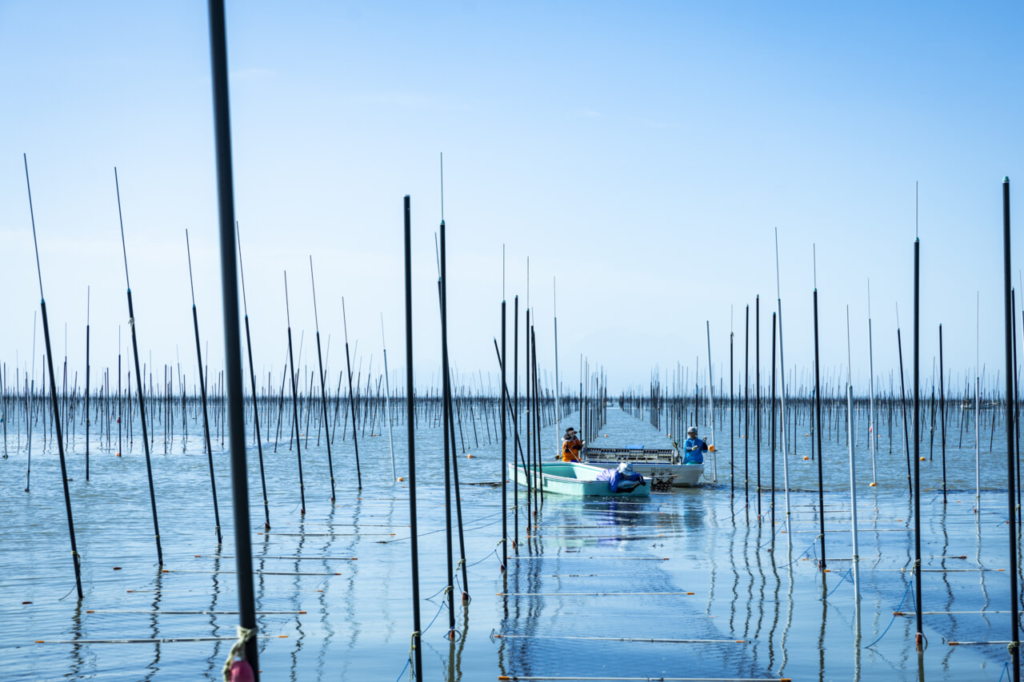
Even within the same Ariake Sea, the conditions of the sea vary from place to place, depending on the climatic conditions of the year, the tidal currents in different locations, the depth of the sea, and other factors. In other words, the conditions have such an influence on the quality of the laver. However, it is customary to draw lots every year to determine where the nets will be set. Whether or not the seaweed can be cultivated in the desired location is a matter of luck.
However,” says Koga, ”the best fishermen show their skills by finding the best place to cultivate quality seaweed in a given environment. For example, if you hit a place where the tide is running fast, there is a good chance of growing good quality laver, but it is difficult and time-consuming to work on the boat, he says. In such cases, Koga uses his experience as a fisherman to prepare for the fishing season by making the fishing grounds sturdier than usual, and he uses the fishing grounds he has selected for that year to win the battle.
Development of original products after adversity
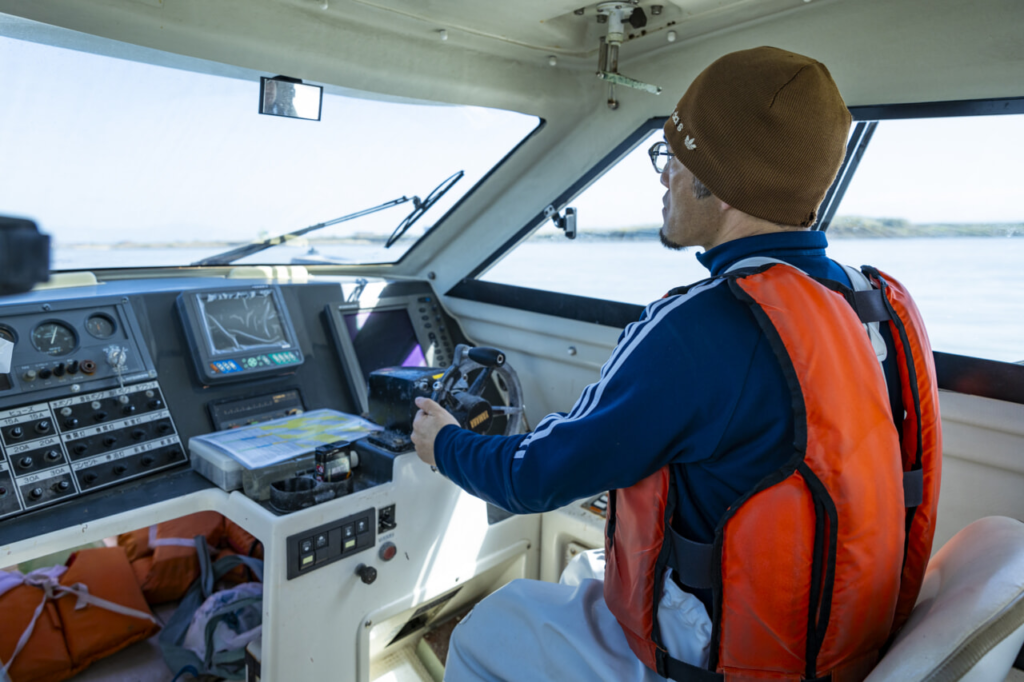
Koga, the third generation of Ariake Suisan, has been helping out in the family business since he was a student, and after graduating from college, his father encouraged him to pursue this career. At first I didn’t like the laver business and did it reluctantly. However, when I had the opportunity to sell my own laver as a product and interacted directly with customers, I strongly felt a responsibility for quality, wanting to live up to their expectations with delicious taste. It was a moment that changed the tide in my mind,” he recalls.
While most seaweed fishermen in the Ariake Sea were shipping all the seaweed they harvested to the fishermen’s cooperative, Ariake Suisan manufactures and sells its own original products. The background behind the creation of the products was changing social conditions and the deteriorating fishing environment.
From the 1990s onward, the wave of the collapse of the bubble economy swept over Kyushu. Furthermore, in 1997, the fishing environment in the Ariake Sea deteriorated due to the closure of the bay on the side of Isahaya City in Nagasaki Prefecture as part of the Isahaya Bay land reclamation project. The treasured sea was struck by a strange phenomenon. In addition, the mass-production and standardized product manufacturing had taken root among the producers, which aggravated the situation, and the industry was on the verge of a downward spiral.
It was during this time that Koga’s father, the previous generation, took on the challenge of creating a new type of laver. His strong desire to break out of the status quo drove him to take on a new challenge.
Unbound by conventional production methods, Koga’s father set out on a new frontier of laver deliciousness
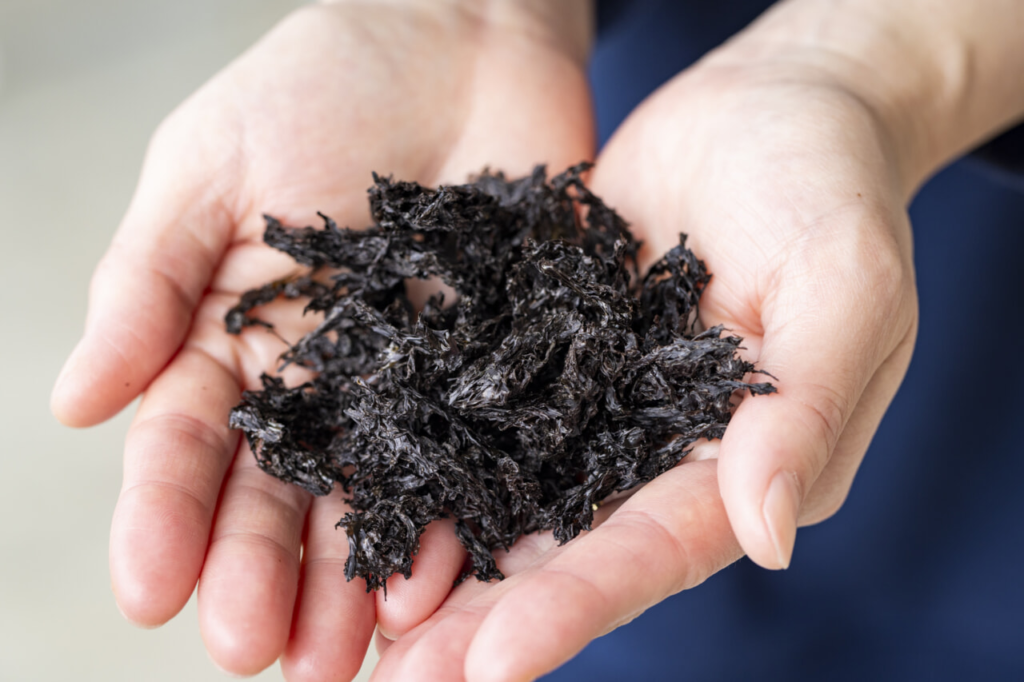
Three years passed with repeated failures and advances. After three years of repeated failures and progress, the company patiently continued to improve the seaweed growing environment and dryers, and the result was “Shisai. The first harvested laver is dried as it is picked without cutting. The appeal of this product is its crunchy texture and softness that instantly melts in the mouth. Another major feature is that the nourishment, flavor, and minerals of the laver itself have not been lost.
Shisai” can be eaten as a snack, as a topping for pasta or ochazuke (rice with green tea), or as an ingredient in soups because of its easy dissolving properties. When used in cooking, it can be added as a finishing touch to maximize the original flavor of the seaweed. It can be arranged in a wider range of ways than conventional ita nori, and it is fun to come up with nori recipes.
Aromatic baked ita-nori is also available
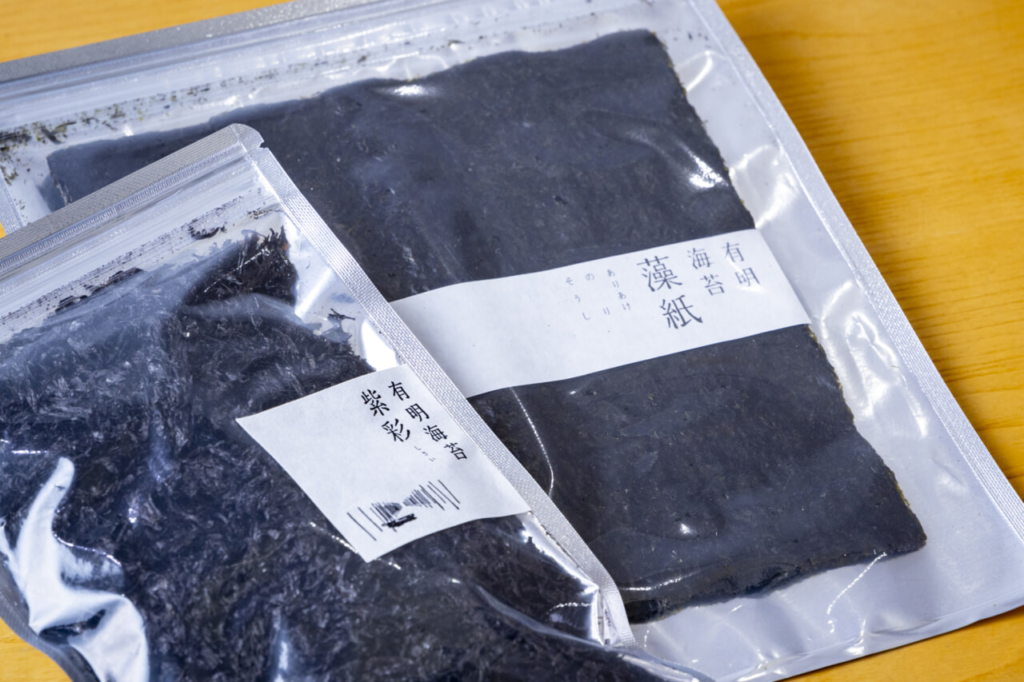
In addition to the original “Shisai,” the company also sells “Moshishi,” a sheet of dried laver that is made by straining the first harvest of laver like Japanese paper and baking it with a delicious aroma. The crispy texture, aroma, and sweetness that wafts through the nose can be enjoyed simply by wrapping it around salted musubi (rice crackers).
The company’s products have gradually spread by word of mouth and have now grown to have fans all over Japan. Mr. Koga himself is able to hear directly from customers through his products, which is a source of inspiration for his daily work.
What does a laver fisherman see for the future of the Ariake Sea?
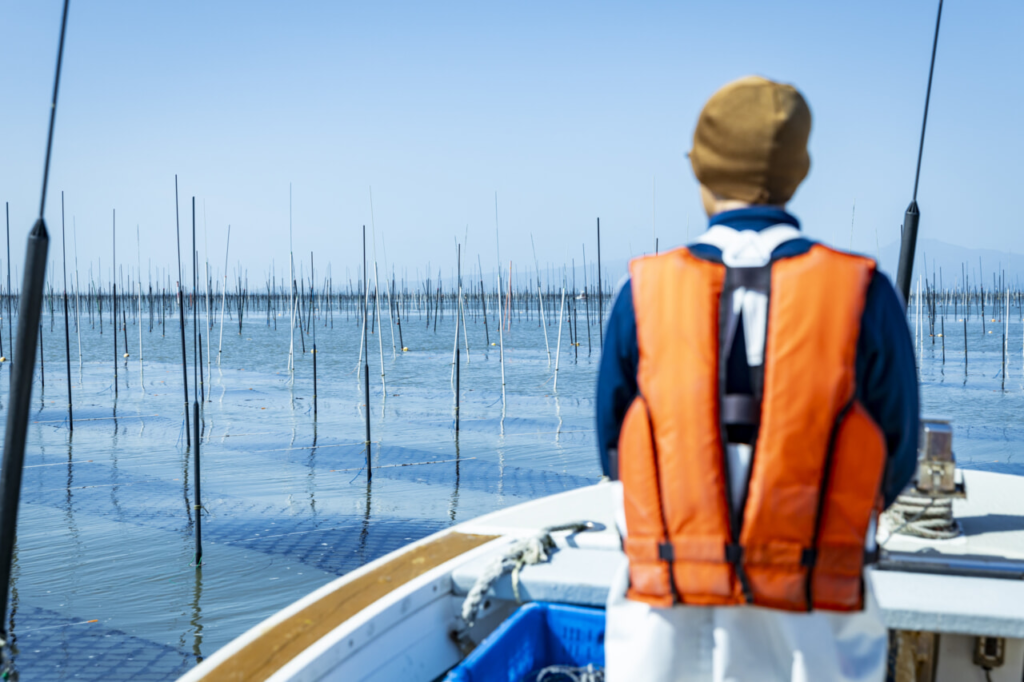
In recent years, seaweed fishermen in the Ariake Sea have been suffering. Due to a lack of nutrients in the sea caused by low rainfall and red tides, the fall and spring seasons of 2022 resulted in a record crop failure. Koga, who had hoped to make a comeback this year, is disappointed that the 2023 season will be the second consecutive poor harvest.
Until now, laver cultivation has been strongly supported by the inherent power of nature. In addition to simply hoping for blessed rains, Mr. Koga is also looking for ways in which people can help to overcome the current situation. One of these is environmental preservation activities.
He is putting his efforts into cleaning up the Chikugo River, saying, “The rich nutrients from the forests flow into the river and nurture the sea. In addition, various other efforts are being made throughout the Ariake Sea, such as efforts to increase the number of plankton-eating bivalves, as the plankton blooms in large numbers deplete the nutrients in the sea. Once again, we make a wish for the next season.
Furthermore, with the desire to develop seaweed cultivation in the Ariake Sea in a sustainable manner as a local industry, the company disseminates information via SNS, opens stalls at events such as marche, and holds workshops. In order to spread awareness of work in the sea and Okawa City, and to contribute to the local community, he also focuses on providing work experience, such as seaweed harvesting, for those who wish to move to Fukuoka. Koga’s duties as a nori fisherman continue not only in the sea, but also outside of the sea.
The Ariake Sea has been called a “treasure sea” since ancient times. We hope that the Ariake Sea will continue to deliver the seaweed that supports Japan’s dining table. Mr. Koga’s challenge will continue in order to continue to be a “treasure” of Japan.
